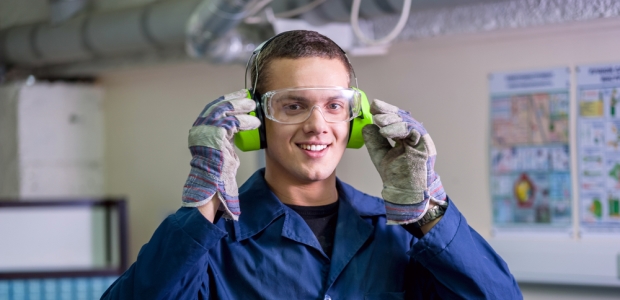
Keys to Preventing Eye Injuries
Prevent Blindness America reports that 90 percent of the more than 2,000 eye injuries occurring each day are preventable through the use of protective safety eyewear.
- By Fred Elliott
- Feb 01, 2016
The best reason to maintain a top-of-the-line PPE program, including employees' critical eye and face protection, is to prevent a life-changing injury. Eye injuries can range from mild—minor bumps and scratches—to serious, eyesight-threatening injuries that demand immediate medical attention.
Common injuries include corneal abrasions, which are scratches on the clear, front surface of the eye. They can result from merely rubbing your eye or from wearing contacts too long, or from a speck of "something" in the eye or being poked in the eye by some object.
Eye specialists caution that discomfort alone is not a reliable indicator of how severe a corneal abrasion is, because even a mild abrasion can cause significant discomfort. Keeping the eye moist with readily available artificial tears—lubricating eye drops—is the best approach, but if the discomfort is severe or becomes worse, keep the eye closed and visit an eye doctor as soon as possible.
There are two types of artificial tears, according to a 2013 article on the Mayo Clinic's website about them:
- Eye drops with preservatives, chemicals that discourage the growth of bacteria. But these preservatives may irritate the person's eyes.
- Preservative-free drops, which are generally recommended for anyone who uses artificial tears at least four times daily or has moderately or severely dry eyes.
Chemical splash is another major cause of eye injuries. Here's where emergency showers and eyewash equipment comes in.
ANSI/ISEA Z358.1-2014, American National Standard for Emergency Eyewash and Shower Equipment, establishes the minimum performance criteria—flow rates, flushing fluid temperature, and drenching patterns—for this type of emergency equipment. Earlier this year, the International Safety Equipment Association posted a free emergency shower and eyewash use and selection guide (https://safetyequipment.org/wp-content/uploads/2015/05/EWS-Guide-Feb_2015.pdf) that is sure to help safety and facility managers maintain and test their equipment to ensure it is in good working order. The 23-page guide includes a Frequently Asked Questions section about the standard, a sample annual inspection checklist, and sections on testing and maintenance, flushing fluid characteristics, hazard assessment, equipment types, freeze protection for emergency equipment, and definitions of terms in the standard.
Imants Stiebris, who chairs ISEA's Emergency Eyewash and Shower Group and is Speakman Company's safety products business leader, said the inspection checklist in the user guide is "a useful tool to verify proper equipment function and ensure that any changes in the area have not affected the safe use and operation of the equipment." The guide will be updated as required to conform to changes in regulations or standards, according to ISEA.
Prevent Blindness America reports that 90 percent of the more than 2,000 eye injuries occurring each day are preventable through the use of protective safety eyewear. The organization created the Eye2Eye education and training program (http://www.eye2eyeprogram.com/) to help in preventing workplace eye injuries. The program aims to help "bridge the gap between safety managers and employees, ensuring increased compliance with workplace eye safety standards and practices," according to the organization. It lists the common causes of these all-too-frequent occupational eye injuries:
- Flying objects
- Tools
- Particles
- Chemicals
- Harmful radiation
Three things workers and safety managers should do to prevent injuries are to know the eye safety hazards at work by completing a hazard assessment, eliminating the hazards through engineering controls before starting work, and wearing appropriate vision protection.
Learn From Others' Mistakes
Recent OSHA enforcement actions illustrate the need to ensure workers' eyes are protected against the hazards they have identified and those also identified in safety directors' hazard assessments. OSHA cited an Alabama lumber mill's operation in October 2015 for two repeat and seven serious safety and health violations after the agency learned a worker had been hospitalized following an unrelated incident. The repeat violations involved fall hazards and unguarded belts, pulleys, and machinery, while the serious citations were issued for the company’s alleged failures to provide safety procedures to prevent machinery from starting up during maintenance and servicing, to provide protective eyewear to workers, and to store compressed gas cylinders properly. OSHA's proposed penalties totaled $43,116.
A second case in October 2015 involved two Oregon ranger districts of the U.S. Forest Service. Four visits by OSHA inspectors in April 2015 found a variety of safety violations that would have resulted in approximately $352,000 in penalties for an employer in the private sector, according to OSHA, with the violations including electrical junction boxes and outlets without covers, failure to require employees to wear eye protection when working with caustic chemicals, ladder hazards, and machine guarding, fall, and fire safety violations.
"It's disappointing when employers that have been previously cited for safety violations continue to expose workers to those same hazards. Situations like this show that worker safety has not been made a priority. This company claims to have a safety management system in place, yet these hazards continue to exist. They must be corrected immediately," Joseph Roesler, director of OSHA's Mobile Area Office, said of the lumber mill's case.
This article originally appeared in the February 2016 issue of Occupational Health & Safety.